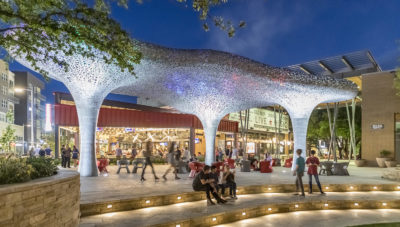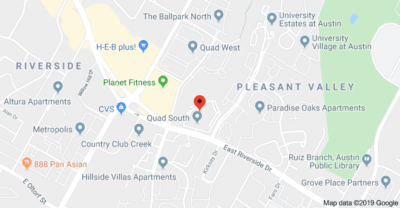Real estate development is strong in Austin, highlighting the continuing job growth bolstering the local economy. Both residential and commercial developments are thriving, with a laundry list of developments in both segments of the industry expected to be available within the year. The types of developments will matter, though, as city leaders are pressured to create ways to encourage housing and economic development. That’s why real estate experts say that mixed-use developments like the Domain are likely to continue to be popular in the Austin area for providing both residential and commercial real estate in areas outside of downtown.
A Growing Need for Mixed-Use Projects
Downtown Austin continues to be a popular place for real estate development, as evidenced by the numerous cranes that accent the skyline. High demand and insufficient inventory are driving up housing costs and commercial rental rates around the city. For example, in East Austin, commercial rents averaged $27.71 per square foot in the second quarter of 2018 according to online real estate services company JLL. In the first quarter of 2019, commercial asking rents in the same area were $51.71.
Increasing rents and property values, as well as strong job growth numbers, are motivating developers to continue to invest in Austin. However, land near the central business district (CBD) is hard to find and costly when found. To solve this, developers are looking outside of the Austin CBD for land to build their projects. That’s one reason why local real estate developer Endeavor Real Estate chose to build their massive, multi-use complex in Northwest Austin.
The Domain
 In 2007, Endeavor Real Estate group purchased about 300 acres of land once owned and occupied by IBM. Over the next decade, the group developed the property into The Domain. It’s a mix of shops, restaurants, offices, hotels and apartments off MoPac Boulevard (Loop 1) in North Austin. It was marketed as Austin’s “Uptown” and succeeded in establishing itself as a destination spot outside of downtown. In fact, the development has proven to be so successful that other developers are replicating it across the country. Here in the Austin area, we’re going to see more of the same.
In 2007, Endeavor Real Estate group purchased about 300 acres of land once owned and occupied by IBM. Over the next decade, the group developed the property into The Domain. It’s a mix of shops, restaurants, offices, hotels and apartments off MoPac Boulevard (Loop 1) in North Austin. It was marketed as Austin’s “Uptown” and succeeded in establishing itself as a destination spot outside of downtown. In fact, the development has proven to be so successful that other developers are replicating it across the country. Here in the Austin area, we’re going to see more of the same.
Recently, the Austin Board of Realtors hosted a panel of industry experts to discuss why the mixed-used development model is working and how to repeat its success.
“It’s really kind of now what the market expects, and as we see other developments being built in this region, we will see them mimic some of the elements of the domain,” said John Hockenyos, president of TXP Inc., an economic development firm.
Corporations like Facebook and Amazon find the mixed-use developments appealing because they can offer affordable commercial space in a highly-desirable city close to affordable housing and packed with amenities.
“The rate for an office tenant in The Domain is roughly 2/3 of what it would cost to be in a class A building downtown,” Marsh said.
Indigo Ridge
 Cedar Park is one of Austin’s fastest-growing suburbs. Earlier this year, Cedar Park City Council voted unanimously to enter a memorandum of understanding with the Indigo Ridge Development Project and the United States Tennis Association Texas (USTA-Texas). The memorandum green-lights the groups to develop a mixed-use project at Whitestone Blvd. and Sam Bass Road.
Cedar Park is one of Austin’s fastest-growing suburbs. Earlier this year, Cedar Park City Council voted unanimously to enter a memorandum of understanding with the Indigo Ridge Development Project and the United States Tennis Association Texas (USTA-Texas). The memorandum green-lights the groups to develop a mixed-use project at Whitestone Blvd. and Sam Bass Road.
Indigo Ridge, or also known as Indigo Ridge North, is planned to include office space, hotel space, residential options, retail, restaurants and entertainment. The memorandum recognizes that Indigo Ridge Development Project is proposing to build a $1.5 billion project over six phases, including more than 2.3 million square feet of commercial, or non-residential, development and more than 2.8 million square feet of residential development, according to Ben White, economic development director for the city of Cedar Park.
During a March 14 meeting Mayor Corbin Van Arsdale called “historic” for Cedar Park City Council, the council voted unanimously.
USTA-Texas will anchor the development and intends to bring its headquarters and facilities to Indigo Ridge. The tennis campus plans to include about 40 outdoor tennis courts, six to eight indoor tennis courts, a stadium court and other amenities.
White said the project is estimated to bring $138.82 million of net new revenue to the city over a 20-year period.
“Those numbers… that allows us to take a lot of pressure off of property taxes for our residents when you deliver projects like that,” Van Arsdale said. “It’s a big deal to have that kind of deal.”
The Grove
Within Central Austin but still well outside of Downtown is The Grove at Shoal Creek development. The 75-acre tract bounded by Shoal Creek Boulevard, West 45th Street and Bull Creek Road is the site of a $750 million mixed-use project. In an article for the Austin-American Statesman, ARG co-owner Garrett Martin told the American-Statesman the start of residential construction on the site is a “historic step for the Grove and for our city.”
“We’ve worked very hard to design an iconic community that will pay tribute to this unique location where future generations will live, work and gather together,” Martin said. “These new homes at The Grove are not only the first step in bringing that vision to fruition, but also the largest collection of homes to be built together in central Austin in decades.”
Once complete, the Grove is projected to have 1,550 residential units. Housing types will include homes, townhomes, condominiums and apartments. The single-family home count totaling 409. In addition, 194 units of more moderately priced housing are planned. Prices for those residences could range from $200,000 to $230,000.
According to the website for the development, the community was envisioned as a thriving entertainment destination. It includes gourmet restaurants, boutiques, exercise studios and specialty merchants. The Grove also features greenspaces, such as an outdoor living room, along with casual corporate offices.
4700 Riverside Drive
 Mimicking the success of the Domain is the anticipated 4700 Riverside Drive project. After a series of highly contentious meetings with City Council, the developers have secured the rezoning they need to develop what were residential properties into a huge mixed-use development. Once complete, 4700 Riverside will include housing, retail, restaurants, offices and a hotel to the 97-acre site. It could have up to 4,700 housing units, several million square feet of office space and hundreds of hotel rooms.
Mimicking the success of the Domain is the anticipated 4700 Riverside Drive project. After a series of highly contentious meetings with City Council, the developers have secured the rezoning they need to develop what were residential properties into a huge mixed-use development. Once complete, 4700 Riverside will include housing, retail, restaurants, offices and a hotel to the 97-acre site. It could have up to 4,700 housing units, several million square feet of office space and hundreds of hotel rooms.
To secure the rezoning, developers Presidium and Nimes Real Estate made a pledge to turn 100 units immediately into transitional housing for the homeless for up to five years. They also threw in a $1.75 million investment to fund in-home health care and social workers to support those residents. The developers entered into an agreement with the Austin-based Ending Community Homelessness Coalition, which will handle the referrals to these units and will receive the $1.75 million.
Additionally, developers have promised that between 400 and 565 housing units will be affordable for people making 60% of Austin’s median family income. That’s a significant contribution to the city’s affordable housing situation. Although median incomes for Austin area residents has risen over the years, the price of housing has risen faster. As a result, more residents with incomes less than the median family income are feeling pushed out of Austin. One development providing roughly 500 affordable housing units can help keep families in Austin by providing immediate housing and also by leading the way for more developers to follow suit.
More Developments Expected
It’s expected that the Austin area population will continue to grow for years to come. Along with it will come more companies that want to take advantage of the population growth. As commercial and residential demand continues to grow, developers will continue to invest in the Austin area. More mixed-use developments will likely make their way to the project pipeline. Rumors of another large mixed-use development have started.
“There is talk of another Domain, just south of downtown,” said Hockenyos. “I think it’s the realization that with the road system that we have, with the transportation infrastructure that we have, we’re gonna have to keep working in this direction.”
Not only does the mixed-use development allow builders to avoid costlier and more congested areas of Downtown, it enables them to invest in the Austin area with less overhead and greater income potential. Buying land to develop outside of the CBD enables them to do both. The benefit to residents is more opportunities to live close to work with easy access to entertainment and daily necessities. For the city, negotiating with developers of mixed-use projects could also mean a way to provide housing for low-income residents or those dealing with homelessness – two hot-button issues facing City Council right now.
In the end, the creation of mixed-use developments in and around Austin will encourage economic development and provide much-needed housing inventory to residents at all income levels. Both the city and its residents will benefit from more desirable places to live and from the availability for companies to take up shop in Austin and offer jobs in different areas throughout the metro. With the added benefit of negotiating for incentives, builders will also benefit from Austin’s low tax burden, high real estate demand and the city’s well-earned prestige as one of the most desirable places to live in the U.S.

